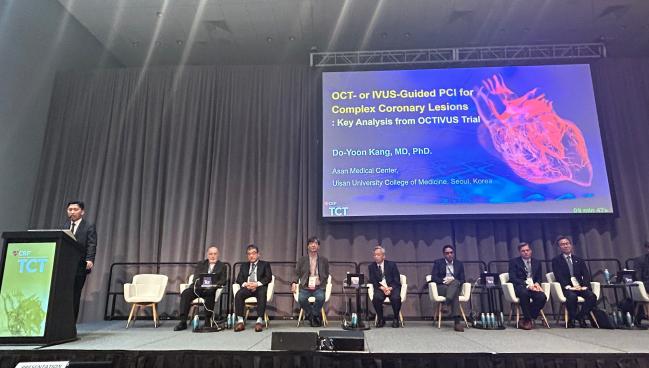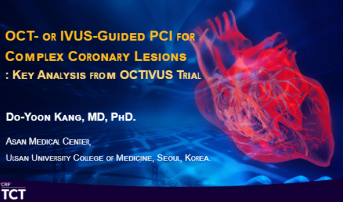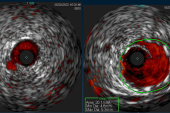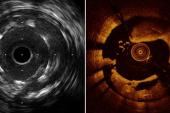OCT, IVUS Both Seem to Be Good Options for Complex Coronary Lesions
These findings, from a prespecified analysis of OCTIVUS, should be considered hypothesis-generating, the researchers say.

SAN FRANCISCO, CA—Among patients with complex coronary lesions, guiding PCI with either optical coherence tomography or intravascular ultrasound appears to yield similar results, according to a prespecified analysis of the OCTIVUS trial.
The rate of target vessel failure was not significantly different based on the type of intracoronary imaging used, Do-Yoon Kang, MD (Asan Medical Center, Seoul, Republic of Korea), reported here at TCT 2023. There were fewer major procedural complications and target vessel MIs when OCT was used.
On the basis of results from OCTIVUS and other recent randomized trials, “either OCT or IVUS can be used safely and efficiently with equally good acute and long-term results in the vast majority of complex PCI procedures,” Kang et al write in a simultaneous publication in the Journal of the American College of Cardiology.
“However,” Kang said during his presentation, “owing to insufficient statistical power and inherent limitations from subgroup analyses, overall findings should be hypothesis-generating and, hence, further research is needed in this area.”
Ziad Ali, MD, DPhil (St. Francis Hospital & Heart Center, Roslyn, NY), the lead discussant following Kang’s presentation, told TCTMD that based on the similar rate of target vessel failure in both groups, the take-home message is that “operators can choose whichever modality they want to use and not really see a difference, even in complex patients.”
A Focus on Complex Lesions
Prior research has shown that PCI guided by intracoronary imaging improves clinical outcomes compared with angiography-guided PCI in patients with complex coronary lesions, and that similar results can be achieved when using either OCT or IVUS. The benefits of intravascular imaging guidance might be even more important for patients with more-complex disease, but the comparative effectiveness of OCT versus IVUS in this setting isn’t clear.
To explore the issue, Kang et al performed a prespecified analysis of OCTIVUS, an open-label trial that compared OCT and IVUS guidance for PCI among patients with a broad range of coronary lesions. The main results showed that use of OCT was noninferior to IVUS guidance in terms of the rate of target vessel failure at 1 year.
The current analysis zeroed in on the 1,475 patients (73.5% of the overall cohort) who had complex coronary lesions, which included unprotected left main disease, bifurcation disease, aorto-ostial lesions, chronic total occlusions, severely calcified lesions, in-stent restenosis, diffuse long lesions, and multivessel disease. In this group, the mean age was about 65 years, and 21% were women.
Lesion characteristics were generally similar in the two arms of the study, although there was a lower proportion of left main disease and a lower mean SYNTAX score in the OCT group. OCT-guided procedures involved a greater amount of contrast dye, but were shorter in duration.
After PCI, IVUS was associated with a higher percentage of lesions that met all stent optimization criteria (46.0% vs 37.6%). There was no difference in the rate of contrast-induced nephropathy between the two groups, but major procedural complications requiring intervention were less frequent in the OCT group (1.7% vs 3.4%; P = 0.03). No complications related to the imaging devices were observed.
Through a median follow-up of 2 years, target vessel failure (cardiac death, target vessel-related MI, or ischemia-driven TVR) occurred in 6.5% of the OCT-guided cases and 7.4% of those guided by IVUS (HR 0.87; 95% CI 0.59-1.29). The lack of difference remained consistent in adjusted analyses.
Most secondary endpoints occurred at similar rates in the two groups, although target vessel-related MI was less common in the OCT arm (0.8% vs 2.4%; P = 0.03).
It’s not clear why major procedural complications or target vessel-related MI would be less common with OCT guidance, Kang et al say, but they point to a couple of possibilities. It could be related to more-aggressive stent sizing with IVUS than with OCT or to an “inherent technical difference of imaging technology [that might translate] into the smaller final minimum stent area with OCT compared with IVUS.”
In subgroup analyses by lesion type, results were generally the same as in the overall analysis, except that in patients treated for in-stent restenosis (11% of the cohort), OCT guidance was associated with a lower rate of target vessel failure compared with IVUS guidance (10.5% vs 29.5%; HR 0.36; 95% CI 0.17-0.78).
This, too, could be related to technological differences between OCT and IVUS, the investigators suggest. “Given OCT’s higher resolution and ability to delineate the composition of different plaque morphologies, OCT is superior to IVUS in assessing stent failure because IVUS cannot assess stent strut coverage, accurately detect thrombus, or categorize the composition of the neointima or neoatherosclerosis,” they write.
During a discussion following his presentation, Kang added, however, that the difference could be due to chance considering the small number of patients in the in-stent restenosis subgroup.
Lesion Type and Imaging Choice
To TCTMD, Ali said a major question in the field is whether intravascular imaging will be particularly useful in specific subgroups. “Because despite the fact that we would love to be able to use it in every single case, the reality is the finances of that are just not going to happen, especially not globally,” he explained.
To that end, there has been a focus on patients with complex coronary disease in recent years, starting with the RENOVATE-COMPLEX-PCI trial published earlier this year. That study demonstrated that intravascular imaging—either OCT or IVUS—lowered the risk of target vessel failure. In contrast, ILUMIEN IV—for which Ali was the global principal investigator—didn’t demonstrate a significant difference between OCT and angiography for PCI guidance in patients with high-risk lesions.
ILUMIEN IV did show, though, that OCT lowered the rate of procedural complications, as was seen in the current OCTIVUS analysis. One of the potential reasons, Ali said, is that IVUS is being used in a more-complex patient population. However, the OCTIVUS analysis showed that the difference between the OCT and IVUS groups remained even after statistically accounting for differences in patient characteristics.
It's also possible, Ali said, that the superior resolution of OCT is allowing complications—and target vessel-related MI—to come down compared with when IVUS is used. In ILUMIEN III, he noted, IVUS was shown to miss about half of what OCT was able to pick up.
Though both OCT and IVUS represent good options for guiding PCI, the choice of modality for a specific case may come down to the types of lesions that are being treated, Ali suggested.
“In general, the sort of interventional dogma is that for in-stent restenosis, for calcium, for general routine PCI, OCT may be a little bit easier, but for complex PCI, like chronic kidney disease, chronic total occlusions, left main coronary arteries, [or] ostial disease, IVUS is advantageous,” he said. “Those are the subsets that I still think, at least in my practice, I would still use IVUS in preference, but I think what this study does is it does show you that overall in complex patients it doesn’t really impact you which modality you use.”
Todd Neale is the Associate News Editor for TCTMD and a Senior Medical Journalist. He got his start in journalism at …
Read Full BioSources
Kang DY, Ahn JM, Yun SC, et al. Guiding intervention for complex coronary lesions by optical coherence tomography or intravascular ultrasound. J Am Coll Cardiol. 2023;Epub ahead of print.
Disclosures
- The study was funded by the CardioVascular Research Foundation, Abbott Vascular, and Medtronic.
- Kang reports no relevant conflicts of interest.
- Ali reports consultant fees/honoraria/speaking fees from AstraZeneca, Abiomed, Boston Scientific, Philips, CathWorks, Medtronic, and Shockwave Medical; grant support/research contracts from Abiomed, Abbott, ACIST, Boston Scientific, Medtronic, Opsens, Philips, Teleflex, CathWorks, Chiesi, Conavi Medical, and Nipro Medical; and equity/stocks/options from Elucid and Shockwave Medical.






Comments